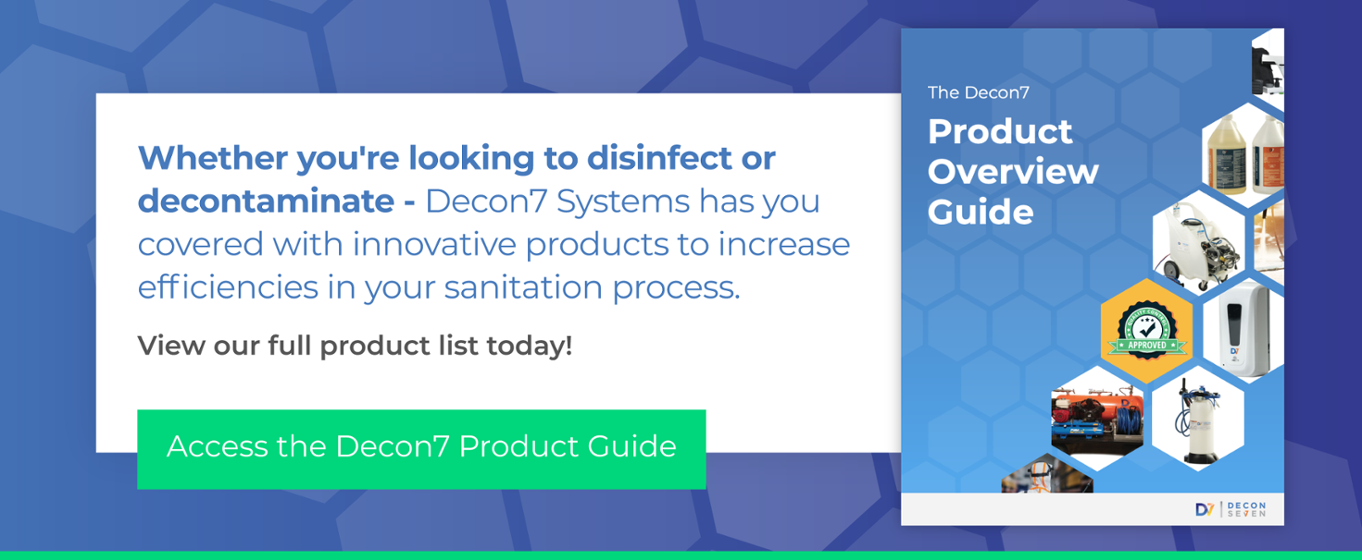.png?width=900&name=D7-Blog%20%2386_Header%20(3).png)
Disinfecting a facility often requires different types of equipment depending on the nature of the facility and the materials and surfaces you’re treating. When there are areas where wall-mounted hoses can’t reach, that are difficult to reach with larger equipment, or with large surfaces that need to be treated, portable solutions like handheld electrostatic sprayers are helpful.
Schools, salons, gyms, restaurants, and other facilities have found that this type of equipment makes it easier to apply disinfectant throughout the day. The portable, handheld units can be easily stowed away when not in use and make the application process simple and straightforward. But guess what: You don’t need a handheld electrostatic sprayer to get the same advantages.
What Is a Handheld Electrostatic Sprayer?
A handheld electrostatic sprayer is a self-contained, portable sprayer that applies an electrostatic charge to water-based disinfectants as they are being sprayed. This positive charge causes the droplets in the disinfectants to repel one another and creates an even spray pattern on surfaces, helping ensure that all areas are covered during the application process.
The battery-powered equipment is lightweight and portable, making it easy for teachers, servers, stylists, and other professionals to quickly apply disinfectant to surfaces as needed. Because the disinfectant is evenly distributed, it also helps ensure that the entire area gets treated with minimal waste and no liquid pooling. Electrostatic sprayers are more efficient than wipes and achieve more consistent coverage than a typical sprayer with most water-based disinfectants.
How to Get Similar Effects Without an Electrostatic Sprayer
Although electrostatic sprayers offer many benefits, one of the downsides is that the battery has to be charged. Without power, the positive charge cannot be applied to the disinfectant while it’s being sprayed. Although this is a minor inconvenience, it can negatively affect compliance if the equipment is not ready to use as needed.
Another solution is to use a product that doesn’t need to be positively charged in order to achieve the same even distribution on surfaces. If you take this approach, you don’t need to purchase additional equipment and users still get the benefits of easy application without worrying about keeping batteries charged.
Why D7 Doesn’t Require an Electrostatic Sprayer
D7 already has a positive charge because it contains cationic surfactants. This means that an electrostatic sprayer is not necessary to achieve a similar consistent spray pattern. D7 accomplishes that every time, without the help of specialized equipment. Simply mix the formulation parts with water at the ratios recommended on the label and spray surfaces to get an even mist that covers every square inch of a surface, every time.
D7 kills a minimum of 99.9999 percent* of pathogens, making it more effective than many of the commonly used disinfectant sprays. With low toxicity and corrosivity, it is safe for both people and the surfaces getting treated.** D7 is also on the EPA’s list of approved disinfectants against coronavirus, so you can be confident that it’s effective.
D7 Offers Disinfectant Products and Equipment
Increased demand has made it difficult to find handheld electrostatic sprayers. Although this type of equipment is not necessary to use with D7, Decon7 has them in stock so you can purchase them to use with the water-based disinfectants you have on hand. However, if you’re looking for a long-term solution, try D7 instead. No special equipment is required to achieve the same effect, and you don’t have to worry about keeping batteries charged for every application.
If you’d like to learn more about all of D7’s disinfection products and application equipment, download our free Product Overview Guide today.
*See label for specific use instructions
**Following specific use and PPE instructions

